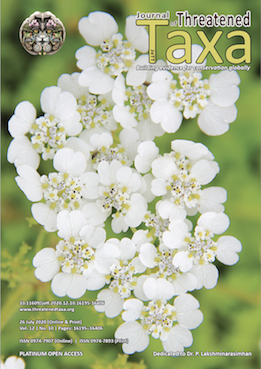Ecology of the Critically Endangered Singidia Tilapia (Teleostei: Cichlidae: Oreochromis esculentus) of lake Kayanja, Uganda and its conservation implications
Main Article Content
Abstract
Singidia Tilapia Oreochromis esculentus is a Critically Endangered native tilapia fish species endemic to lakes Victoria and Kyoga basins of East Africa, however, it disappeared from these main lakes due to overfishing, environmental degradation and predation by the introduced Nile Perch Lates niloticus. Remnant populations of this fish species is now restricted to satellite lakes including Lake Kayanja of the Victoria basin. This study provides updated information about the population abundance, critical habitat, threats and diet of Singidia Tilapia to inform conservation decisions to revive its populations in the wild. Fish data collection and mapping of nursery and breeding habitats of Singidia Tilapia on Lake Kayanja was conducted between February 2016 and October 2017. In all the areas mapped and sampled, Singidia Tilapia (with a size range of 11–27 cm TL) was the most abundant (43%) relative to exotic Nile Tilapia Oreochromis niloticus (21%) and Redbelly Tilapia Coptodon zillii (36%). The emergence of introduced (exotic) tilapias like Nile Tilapia recorded in this study could be attributed to cage fish farming being carried out in this Lake. The diet of Oreochromis esculentus consisted mainly of detritus (60.8 %), plant materials (27.7%) and blue-green algae (5.5%). Destruction of critical habitats and presence of introduced fish species were noted as the major threats to this fish and its habitats. The generated information could contribute to guiding stakeholders to undertake appropriate actions to conserve this threatened fish species and its habitats.
Article Details
Authors own the copyright to the articles published in JoTT. This is indicated explicitly in each publication. The authors grant permission to the publisher Wildlife Information Liaison Development (WILD) Society to publish the article in the Journal of Threatened Taxa. The authors recognize WILD as the original publisher, and to sell hard copies of the Journal and article to any buyer. JoTT is registered under the Creative Commons Attribution 4.0 International License (CC BY), which allows authors to retain copyright ownership. Under this license the authors allow anyone to download, cite, use the data, modify, reprint, copy and distribute provided the authors and source of publication are credited through appropriate citations (e.g., Son et al. (2016). Bats (Mammalia: Chiroptera) of the southeastern Truong Son Mountains, Quang Ngai Province, Vietnam. Journal of Threatened Taxa 8(7): 8953–8969. https://doi.org/10.11609/jott.2785.8.7.8953-8969). Users of the data do not require specific permission from the authors or the publisher.
References
Amisah, S. & I.G. Cowx (2000). Response of the fish populations of the River Don in south Yorkshire to water quality and habitat improvements. Environmental Pollution 108(2): 191–199. https://doi.org/10.1016/s0269-7491(99)00190-6 DOI: https://doi.org/10.1016/S0269-7491(99)00190-6
Balirwa, J.S., C.A. Chapman, L.J. Chapman, I.G. Cowx, K. Geheb, L. Kaufman, R.H. Lowe-McConnell, O. Seehausen, J.H. Wanink, R.L. Welcomme & F. Witte (2003). Biodiversity and fishery sustainability in the lake victoria basin: An unexpected marriage? BioScience 53(8): 703–715. https://doi.org/10.1641/0006-3568(2003)053[0703:BAFSIT]2.0.CO;2
Balirwa, J.S., F. Witte, R.L. Welocomme, L. Chapman & R.H. McConnell (2000). The Role of Conservation in Biodiversity and Fisheries Sustainability. In: Lake Victoria 2000: a New Beginning. International Conference, 16th–19th May, 2000, Jinja, Uganda. Book of abstracts.
Chapman, L.J., C.A. Chapman, L. Kaufman, F. Witte & J.S. Balirwa (2008). Biodiversity conservation in African inland waters: Lessons of the Lake Victoria region. SIL Proceedings, 1922–2010. https://doi.org/10.1080/03680770.2008.11902077 DOI: https://doi.org/10.1080/03680770.2008.11902077
Dudgeon, D., A.H. Arthington, M.O. Gessner, Z.I. Kawabata, D.J. Knowler, C. Lévêque, R.J. Naiman, A.H. Prieur-Richard, D. Soto, M.L.J. Stiassny & C.A. Sullivan (2006). Freshwater biodiversity: Importance, threats, status and conservation challenges. Biological Reviews of the Cambridge Philosophical Society 81(2): 163–182. https://doi.org/10.1017/S1464793105006950 DOI: https://doi.org/10.1017/S1464793105006950
Elliott, J.M. & T.B. Bagenal (1979). Methods for Assessment of Fish Production in Fresh Waters. The Journal of Animal Ecology 48(1): 329. https://doi.org/10.2307/4121 DOI: https://doi.org/10.2307/4121
Greenwood, P.H. (1966). The Fishes of Uganda. The Uganda Society, Kampala, 131pp.
Hynes, H.B.N. (1950). Food of the freshwater stickle-backs (Gasterosteus aculeatus and Pygosteus pungitius) with a review of methods used in the studies of the food of fishes. Animal Ecology 19(1): 36–58.
Lowe-McConnell, R. (2009). Fisheries and Cichlid Evolution in the African Great Lakes: Progress and Problems. Freshwater Reviews 2(2): 131–151. https://doi.org/10.1608/FRJ-2.2.2 DOI: https://doi.org/10.1608/FRJ-2.2.2
Mwanja, W.W. P.A. Fuerst & L. Kaufman (2012). Reduction of the “ngege”, Oreochromis esculentus (Teleostei: Cichlidae) populations, and resultant population genetic status in the Lake Victoria Region. Uganda Journal of Agricultural Sciences 13(2): 65–82.
Nagayi-Yawe, K.J., R. Ogutu-Ohwayo, Y.S. Kizito & J.S. Balirwa (2006). Population characteristics of Oreochromis esculentus in the Victoria and Kyoga lake basins. Implications for conservation and improvement of the stocks. African Journal of Ecology 44: 423–430. https://doi.org/10.1111/j.1365-2028.2006.00645.x DOI: https://doi.org/10.1111/j.1365-2028.2006.00645.x
Njiru, M., J. Kazungu, C.C. Ngugi, J. Gichuki & L. Muhoozi (2008). An overview of the current status of Lake Victoria fishery: Opportunities, challenges and management strategies. In: Lakes and Reservoirs: Research and Management 13(1): 1–12. https://doi.org/10.1111/j.1440-1770.2007.00358.x DOI: https://doi.org/10.1111/j.1440-1770.2007.00358.x
Ogutu-Ohwayo, R. (1990). The decline of the native fishes of lakes Victoria and Kyoga (East Africa) and the impact of introduced species, especially the Nile perch, Lates niloticus, and the Nile tilapia, Oreochromis niloticus. Environmental Biology of Fishes 27: 81–96. https://doi.org/10.1007/BF00001938 DOI: https://doi.org/10.1007/BF00001938
Ogutu-Ohwayo, R. & J.S. Balirwa (2006). Management challenges of freshwater fisheries in Africa. Lakes and Reservoirs: Research and Management 11(4): 215–226. https://doi.org/10.1111/j.1440-1770.2006.00312.x DOI: https://doi.org/10.1111/j.1440-1770.2006.00312.x
Twongo, T.K., J.D.R. Bayona & M. Hanssens (2006). Oreochromis esculentus. The IUCN Red List of Threatened Species 2006: e.T15457A4587658. Downloaded on 16 June 2020. https://doi.org/10.2305/IUCN.UK.2006.RLTS.T15457A4587658.en DOI: https://doi.org/10.2305/IUCN.UK.2006.RLTS.T15457A4587658.en

